The Best Leaf to Date, But Can It Go the Distance?
The Nissan Leaf was the first mass-market all-electric vehicle. Despite other EV upstarts making gains, it’s still the top-selling electric car in history, with more than 500,000 sold worldwide. In the 10 years it has been on the market, it’s won about every award for green automobiles, including the World Green Car award twice.

For 2020, the Leaf carries over continued refinement and enhancement. There are five models available for 2020–the 40 kilowatt-hour (kWh) S and SV, the 62 kWh S Plus, SV Plus and top-of-the-lineup SL Plus.
We wanted to see how the 2020 Leaf stacked up to previous Leafs in our annual flat lands-to-the-Sierra trip and back. Nissan was happy to oblige and delivered us a 2020 Leaf SL Plus for evaluation.
What’s New for 2020
The fit and finish of the Leaf’s panel gap, paint finish quality improvements and noise, vibration, and harshness (NVH) reductions have greatly improved compared to previous years. The cabin is whisper-quiet with average noise at 59 dB, which is down from 62 dB in past years. The wind noise is much less from previous Leaf models, which appears to be the reason for the quieter interior. The electrically assisted steering has a much-improved and solid feel. The suspension is never harsh, but stable and smooth. Bumps and dips are never sloppy or choppy. Combined with the Nissan Zero Gravity seating, it’s a car you can ride in all day and not feel tired or sore. The interior also gets new USB-A and USB-C ports in the front, and 2 USB-A charging ports for the rear seats. The Leaf continues its ability to update itself with over-the-air (OTA) software improvements. Managing the Leaf from your smartphone is improved.

Other key improvements and additions include:
- Nissan Safety Shield 360 now standard on all models: automatic emergency braking with pedestrian detection, rear automatic braking, rear cross traffic alert, blind spot warning lane departure warning, and high beam assist.
- Additional standard features on all models include Intelligent Forward Collision Warning, Intelligent Lane Intervention and Blind Spot Intervention.
- The standard 8.0-inch color touchscreen display is now on all 40 kWh Leaf models.
- Leaf S features standard Apple CarPlay and Android Auto.
- Driver and front passenger knee supplemental airbags, rear seat-mounted outboard side-impact additional airbags added to all models.
- Intelligent Around View Monitor and Intelligent Driver Alertness added to SV Technology Package.
- The 2020 Leaf also gets new sounds for its pedestrian safety sound and backup warning. After 10 years of production, the Leaf finally gets a grown-up horn that sounds like it came out of a truck. It is much more assertive than in years past.
What About the Battery?
The top criticism of the first-generation Leaf was its battery design, which lacked active thermal management and had a tendency to experience premature degradation.

Since then, Nissan has been continuously improving the design of the battery, and in 2018 and 2019, Nissan introduced the second-generation of the Leaf battery in two sizes–40 kWh and 62 kWh. These two batteries use new cells with new architecture and chemistry that is much more powerful than the first-generation ones with output power now at 110 kW vs. 80 kW in the earlier cars. The modern architecture’s chemistry and extra power is carried over to 2020, with the new structure and module layout.
First-generations of the Leaf’s battery used a lithium manganese oxide cathode material in a spinel structure. The current 40 and 62 kWh batteries use a lithium nickel cobalt manganese oxide cathode in a layered structure, which is much more durable and heat tolerant.
The 40 kWh battery still has 192 cells, but the module layout of the 40 kWh battery is different, with 24 modules of eight cells each vs. 48 modules of four cells each in the older obsolete 24 and 30 kWh batteries.

The 62 kWh pack has three different module shapes, each with a different number of cells (12, 21, 27 cells). The 62 kWh pack’s cells are laminated, and there are 288 of them vs. 192 in the 40 kWh packs. The 62 kWh battery has three power lines to the motor and inverter while the 40 kWh version has two.
The battery cell layouts, along with an improved battery management system (BMS), allows the battery to operate more efficiently and durably under full power and charging loads.
These batteries can do this without needing dedicated thermal management hardware, hardware cost and achieve reliability levels on par with every other thermally managed BEV battery on the market today. Nissan’s goal was to provide optimum reliability for the battery without add-ons and to solve the problem by making the core battery architecture more durable and reliable.

During our time in the Leaf Plus, the battery temperature stayed pretty much right in the center of the gauge. It did not matter if we were going uphill, downhill or charging; the Leaf kept its cool.
Starting around early 2016, Nissan developed these batteries at the Stanfield, Arizona, proving grounds, which is in one of the hottest areas in Arizona and the United States. Customer deliveries started in 2018, and over four years of real-world testing and usage has shown the new battery design can take the heat with the best of them. It is tough to find any report of Leafs with the new battery showing any degradation like the first-generation 2010-2017 Leafs have shown. This new battery design has proven itself so well that the 40 kWh version is now the warranty replacement solution for 2016-17 30 kWh Leafs.
While it took Nissan quite a few years to perfect this design, but they have figured out the secret sauce. It must be working because of the lack of degradation complaints from second-generation Leaf owners.
The question today isn’t: “Why isn’t Nissan using active thermal management?” Instead, it should be: “Why are all the other BEV manufacturers still using active thermal management?”
How Efficient Is the Leaf?
Efficiency has been a discussion that has come up recently for all BEVs. The question boils down to how many miles can a BEV travel on a kilowatt of electricity. This measurement considers the aerodynamics and rolling resistance of the vehicle, how efficient its motor is, and how much power the battery produces as energy rather than heat.

This question can become very technical very quickly. We have come up with a more straightforward metric. How far can a BEV go on a course that represents a range of typical driving terrains and conditions a driver may encounter.
We have just the long-distance route that we have driven for decades that includes urban and rural roads, fast interstates, and steep mountain and flat highways with strong head and tail winds. The route is about 226 miles in each direction from San Jose to Lake Tahoe.
Our route starts on the West Coast of California on interstates that wind through rolling hills to the Central Valley and Sacramento. This drive is mostly at sea level on Interstate 5, which has a 70-mph speed limit. From Sacramento, we switch to Highway 50 and start our ascent to Lake Tahoe, which will take us from 225 feet to a 7400-foot summit and then down to 6200 feet and our destination. This section is 105 miles and has an average elevation gain of 70 ft./mile.

Our goal was to get from San Jose to Lake Tahoe on one charge and then do it again in the other direction. The Leaf SL Plus we were driving has an EPA rating of 226 miles, so on paper at least we should just barely be able to get there.
The Leaf was charged the night before the trip to 100 percent. Its estimated range gauge (also known as the Guess-O-Meter (GOM)) indicated we had 241 miles of range available. Of course, we didn’t expect to make it up to Tahoe on one charge because of the elevation gain, but we wanted to see how short we would be. The speed limit between Sacramento and Lake Tahoe ranged from 65 mph to 35 mph. We tried to stay with traffic, but took it easy at the speed limit or below on especially steep sections.
By the time we got to Pollock Pines Ca. (elevation 3648 ft.), we had traveled 181 miles and still had 47 miles to go with another 3752 ft. in elevation gain left to get over the 7400 ft. summit. Our GOM indicated that we had 37 miles of range left, so at best, we were going to be at least 10 miles short. Not too shabby, but still short.
Luckily the route we had chosen is part of California’s “Drive the Arc” fast-charge network. There is a pair of CHAdeMO/CCS pedestals right off the highway in Pollock Pines. We pulled in and set up a 15-minute charge/bio-break. That gave us an additional 44 miles of range for a total of 81 miles, more than enough to get to our hotel in Tahoe, and enough range remaining for our next day’s adventures at the lake.

Our overall efficiency for the drive from San Jose to Tahoe was a very respectable 3.5 miles/kWh. If we included the next day’s driving, the efficiency was up to 3.7 miles/kWh. That’s 255 miles total with an elevation gain of 7175 ft. over the last 105 miles.
For the return trip, we followed the same route downhill. This segment was a bit slower because of all the truck traffic, but we held our place with all of the SUVs, pickups and regular cars. The Leaf’s efficiency soared going downhill, and it became a game to see how much more than 300 miles of range we could hold onto. About 38 miles into the downhill trip, the Leaf was averaging 9.3 miles/kWh with a GOM range of 317 miles. By the time we got to North Sacramento and 105 miles into the trip, we were averaging 8.1 miles/kWh and a total range of 340.6 miles.
Our Leaf came equipped with Nissan’s ProPilot Assist, which made the downhill ride much less stressful.
After we left Sacramento, we were on the flatlands to San Jose and driving at 70 mph. Two and a half hours later, we drove up to our driveway with a total distance of 225.6 miles and 44 miles of range left on a single charge for an average downhill energy efficiency of 5.1 miles/kWh. The average up and downhill efficiency for the roundtrip of 452 miles was 4.3 miles/kWh.
Answer: Very efficient!
In anyone’s BEV efficiency book, 4.3 miles/kWh is excellent efficiency. There are other BEVs that brag that they can achieve 4.5 miles/kWh on a flat road, but not many have shown that they can match the Leaf on a course like the one we undertook.
The real-world range on the Leaf Plus far exceeds the car’s EPA ratings. As has been shown with other BEVs, the Leaf has much more range than its advertised rated range. The EPA range for this Leaf is 225 miles, but we could easily beat that by 44 miles. If we had been on a flat road course, the magic 300 miles to a charge might have been within reach.
How Fast Is the 2020 Leaf?
With its more powerful motor, the Leaf Plus has a 0-to-60 time of about 6.5 seconds (or about the same as my 1966 Shelby GT350.) The standard range Leaf came in at about 7.4 seconds. The Leaf is limited to 100 mph top speed.
What about the Leaf’s cargo and interior space?

The Leaf interior is still one of the most spacious ones available for a mid-priced BEV and leads the pack when it comes to cargo space.
Here is how the Leaf compares to other BEVs on the market today. These measurements are from both the manufacturers listings and from actual measurements.

How Much Does the Leaf Cost?
MSRPs for the Leaf trims are:
S 40 kWh – $31,600
SV 40 kWh – $34,190
S Plus 62 kWh – $38,200
SV Plus 62 kWh – $39,750
SL Plus 62 kWh – $43,900
Destination charges: $925
All Leafs still qualify for the Federal $7,500 tax credit and other state and local rebates and incentives. Nissan offers other incentives for qualified buyers and lessors on 2020 Leafs as well as remaining 2019 Leafs. These incentives, discounts, and credits can significantly reduce the actual price.
Reliability and Warranty
The Leaf is one of the most reliable battery-electric vehicles on the road today. Many Leaf owners worldwide report that they have never had a warranty claim ever on their cars. First-generation Leaf owners say the same thing except for those who reported excessive battery degradation. Early owners report: “Built like a rock, but the battery sucks.” Today’s second-generation owners say: “Built like a rock, love the range and durability of the new battery.”

The Leaf new car warranty includes three-year/36,000-mile (whichever occurs first) basic coverage and five-year/60,000-mile (whichever occurs first) powertrain coverage. Emissions warranties are two-years/24,000 miles for performance, Three-years/36,000-miles for defects, and eight-years/80,000 miles for long-term defects.
The Nissan Leaf lithium-ion battery limited warranty includes coverage for defects in materials or workmanship for eight years/100,000 miles (whichever comes first) as well as protection against capacity loss below nine bars of capacity (out of 12), as shown on the Nissan Leaf’s capacity gauge for eight years/100,000 miles (whichever comes first.)
Should the 2020 Leaf Be on Your Consideration List?
If you are in the market for a battery-electric vehicle, it should be absolutely on your shortlist! The Leaf is somewhat of an underdog these days because of Nissan’s management soap opera, the shortcomings of the first-generation Leaf battery and the shiny ego-rubbing baubles coming from Tesla. Despite all of that, the Leaf (especially the Plus model) is still one of the best buys in a BEV today.
The Leaf Advantages
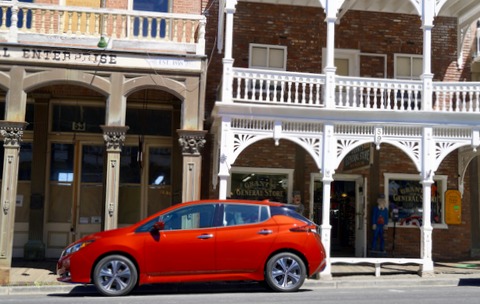
• Top notch reliability, fit, and finish.
• Excellent ergonomics and cabin comfort and engineering (Leafs have been using heat pumps for HVAC for seven years, while Tesla is just discovering them).
• The Leaf is a midsize car with more interior and cargo space than almost every one of its competitors.
• The 2020 Leaf’s traction battery and thermal management is completely redesigned with new chemistry and battery management that puts its reliability and durability on par with any other BEV on the market today. It also has the best durability warranty.
• The Leaf has a competitive real-world range with BEVs costing thousands of dollars more.
• The Leaf’s advanced driver assist system (ADAS) ProPilot Assist is on the same level of other ADAS systems from other manufacturers. (ProPilot Assist has never driven a Leaf into another truck or car.)
• The Leaf still has some of the best pricing, including incentives, of any BEV sold today.
• With more than 3,200 CHAdeMO public DC fast chargers available in the US, the Leaf’s national charging infrastructure continues to expand. It’s still growing and is by no means obsolete. Between the Leaf’s range, ability to charge at home and public infrastructure, it makes range anxiety something that you may never have to worry about again.
Story & photos by Gary Lieber (additional photos from the manufacturer)
Related Stories You Might Enjoy—Other EV Options
Road Test: 2020 Kia Niro EV
Road Test: 2020 Hyundai Kona EV
Road Test: 2019 Chevrolet Bolt
Flash Drive: Tesla Model 3 Short Range Plus
News: Ford’s Mach-E: Selling Car Buyers on Going Electric
Road Test: 2020 Mini Cooper SE EV
Road Test: 2019 Nissan Leaf Plus EV
Road Test: 2019 Hyundai Ioniq EV
Disclosure:
Clean Fleet Report is loaned free test vehicles from automakers to evaluate, typically for a week at a time. Our road tests are based on this one-week drive of a new vehicle. Because of this we don’t address issues such as long-term reliability or total cost of ownership. In addition, we are often invited to manufacturer events highlighting new vehicles or technology. As part of these events we may be offered free transportation, lodging or meals. We do our best to present our unvarnished evaluations of vehicles and news irrespective of these inducements.
Our focus is on vehicles that offer the best fuel economy in their class, which leads us to emphasize electric cars, plug-in hybrids, hybrids and diesels. We also feature those efficient gas-powered vehicles that are among the top mpg vehicles in their class. In addition, we aim to offer reviews and news on advanced technology and the alternative fuel vehicle market. We welcome any feedback from vehicle owners and are dedicated to providing a forum for alternative viewpoints. Please let us know your views at publisher@cleanfleetreport.com.

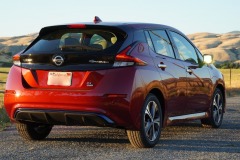
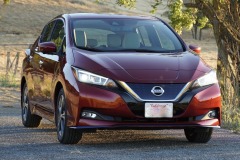
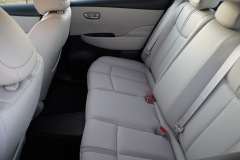
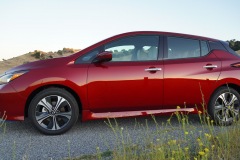

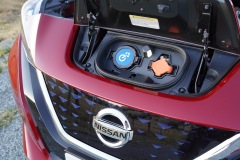

I’m nearing my one year anniversary with my 2019 SL Plus. I say time will tell if Nissan got the battery right. I want to see someone run a Leaf head to head with a Bolt or another similarly priced EV on a cross country trip that requires repeated frequent charge stops. I’ve had a 500-mile day in mine where battery temps were starting to show the stress of multiple charging stops in one day. Even after resting overnight, battery temps were still around 90 degrees, not a place that gives me a warm fuzzy for a second day of being fed another heavy dose of DC charging cycles. This is where thermal management becomes superior. One short DC stop doesn’t make a good assessment of the battery’s ability to handle heat. In addition, Electrify America continues to treat CHAdeMO chargers with open contempt. Part of your trip should include being able to successfully get from point A to B on a multi-day trip, where EA becomes your point of dependency.
@Wolfy, Good points all and great insight into life with an EV. Keep on charging! –ed.